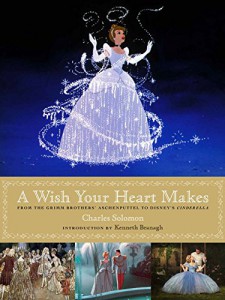 Disney has become synonymous with fairytales over the years and Cinderella is perhaps one of their most iconic titles. For anybody that has ever dreamed that their wishes would come true, it’s an inspirational story that never leaves you. Charles Solomon’s latest book explores the ancient origins of the story, how the Disney animated version became the classic we love today, and explores how Disney’s 2015 version came to be.
Disney has become synonymous with fairytales over the years and Cinderella is perhaps one of their most iconic titles. For anybody that has ever dreamed that their wishes would come true, it’s an inspirational story that never leaves you. Charles Solomon’s latest book explores the ancient origins of the story, how the Disney animated version became the classic we love today, and explores how Disney’s 2015 version came to be.
A Wish Your Heart Makes: From the Grimm Brother’s Aschenputtel to Disney’s Cinderella is a hardcover coffee table book with an introduction by director Kenneth Branagh. The first of three sections is called “Once Upon a Time,” which explores the origins of the story and the many different versions that exist. I was surprised to find that the tale can be traced back to the 1st century in the Greek tale of Rhodopis by Strabo. Other versions have been found in China and Italy, but the most famous version by Charles Perrault called Cendrillon was written in 1697.
This section also follows the story as it traveled through other mediums. It has been adapted as an opera four times, the first was in 1817. It’s also been a ballet by both Johann Strauss II (1901) and Sergey Prokofiev (1945). The first stage musical in America in 1904 was Cinderella and the Prince and Mary Pickford was one of the first stars of the screen to play her in A Kiss for Cinderella, which was written by J.M. Barrie, author of Peter Pan. Walt Disney’s first attempt at the tale was in 1922 with one of his Laugh-O-Gram shorts. Other notable versions include Rodgers & Hammerstein’s adaptation and the Sherman Brothers’ The Slipper and the Rose from 1976.
The second section is “Walt Disney’s Cinderella Story,” which covers the details of how the animated classic came to be. It starts with concept art from the earliest story drafts, which date back to 1940. One of the major story changes from a 1944 version was the prince meeting Cinderella in disguise, a device Disney used in their 1997 version of Rodger’s & Hammerstein’s Cinderella. Walt at one point was planning to have six songs in the film, each by a different famous songwriter of the late 1940’s. This section is surprisingly honest about the rotoscoping that was done for the film, but it makes sense when you consider that rough animation on the film was completed in just six months. There is also a lot of background about the style of Mary Blaire and Ken O’Connor’s layout for the backgrounds, as well as how Ilene Woods became Walt’s Cinderella.
The final section is “A Live-Action Fairy Tale” and is all about the lavish new motion picture from Disney. It covers the subtle ways they modernized the tale while keeping it classic, the casting process, and the inspiration behind the sets and costumes. It’s interesting to see concept art for the ball featuring a white/silver dress for Cinderella, but then to read why costume designer Sandy Powell chose a striking blue instead.
This book is perfect for any fan of Disney’s Cinderella. The section concerning the animated classic is the largest part of the book. Those looking for an immersive art book will be pleased by the collection of rarely seen concept art provided by the Animation Research Library. Fans of the new live action film will be thrilled with that section as well, which offers great insight into production and lots of great preproduction artwork and movie stills. Because it’s in three sections and features lots of art, it’s a fairly quick read and one that you can easily put down and come back to later.
